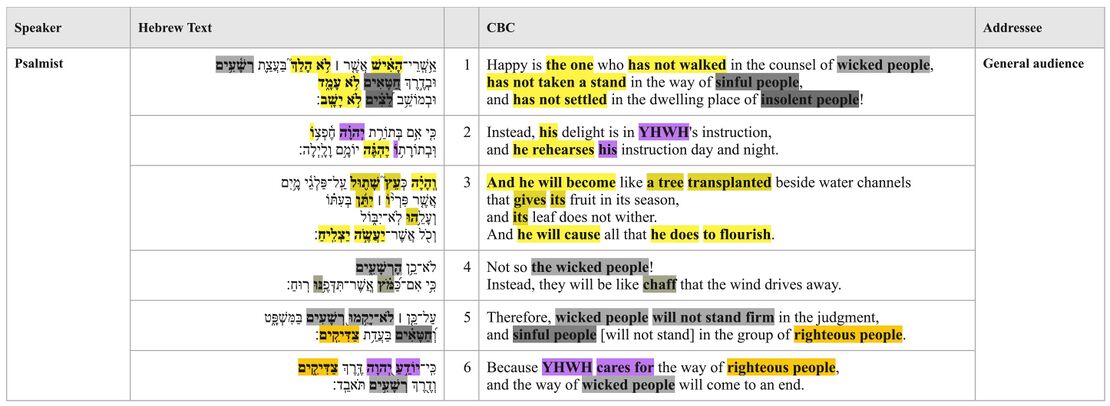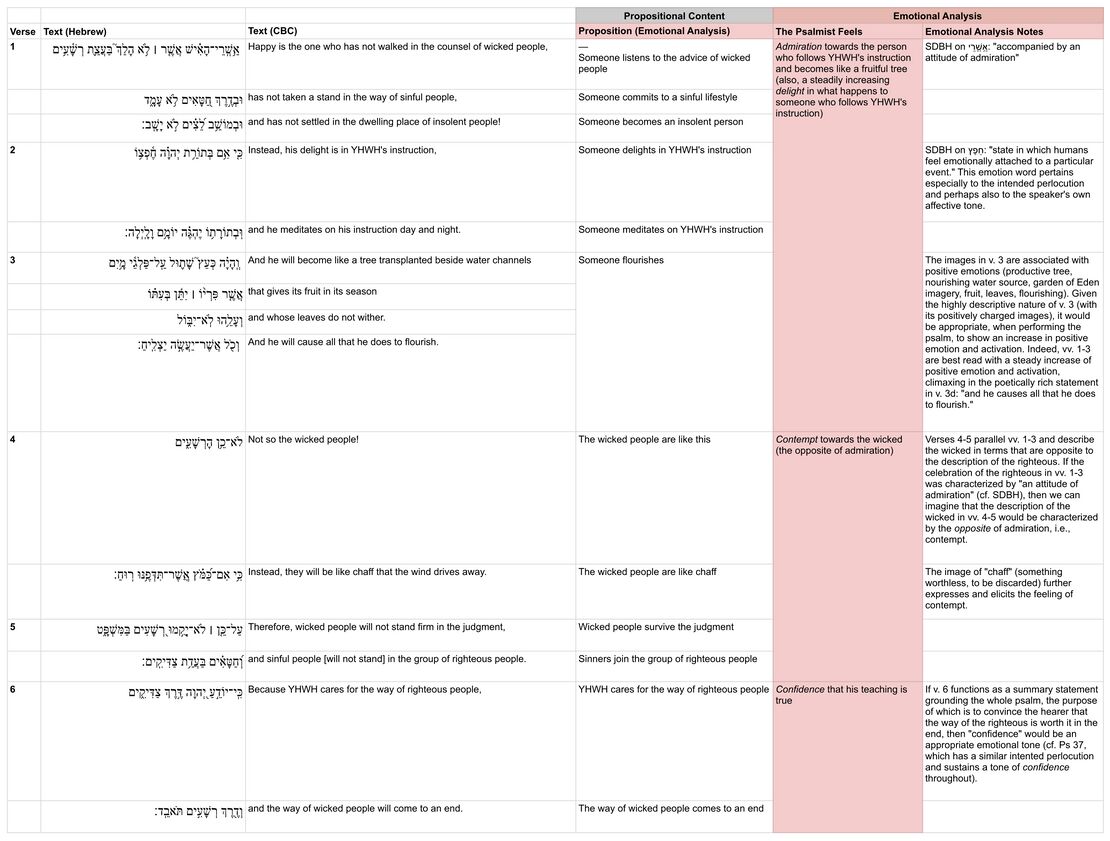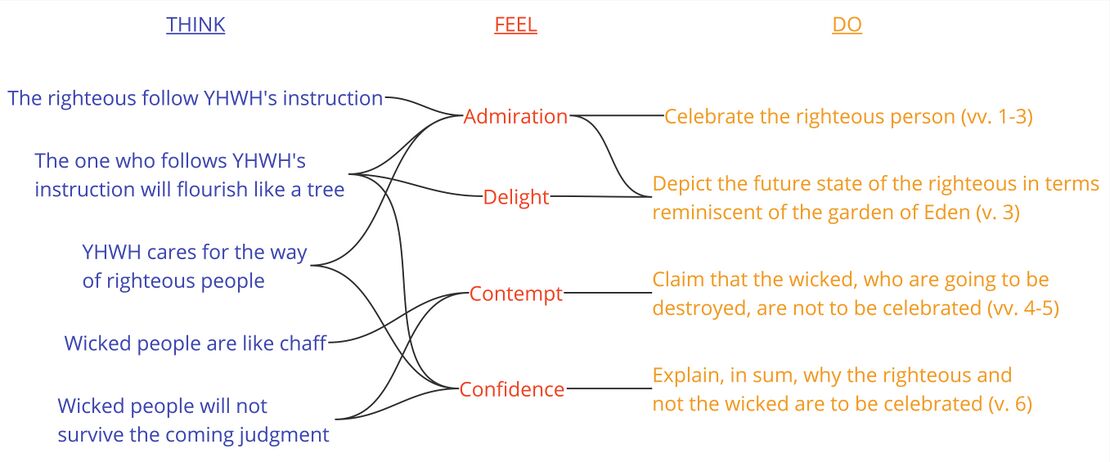Psalm 1 Discourse
About the Discourse Layer
Our Discourse Layer includes four additional layers of analysis:
- Participant analysis
- Macrosyntax
- Speech act analysis
- Emotional analysis
For more information on our method of analysis, click the expandable explanation button at the beginning of each layer.
Participant Analysis
Participant Analysis focuses on the characters in the psalm and asks, “Who are the main participants (or characters) in this psalm, and what are they saying or doing? It is often helpful for understanding literary structure, speaker identification, etc.
For a detailed explanation of our method, see the Participant Analysis Creator Guidelines.
Participant Relations Diagram
The relationships among the participants may be abstracted and summarized as follows:
Macrosyntax
The macrosyntax layer rests on the belief that human communicators desire their addressees to receive a coherent picture of their message and will cooperatively provide clues to lead the addressee into a correct understanding. So, in the case of macrosyntax of the Psalms, the psalmist has explicitly left syntactic clues for the reader regarding the discourse structure of the entire psalm. Here we aim to account for the function of these elements, including the identification of conjunctions which either coordinate or subordinate entire clauses (as the analysis of coordinated individual phrases is carried out at the phrase-level semantics layer), vocatives, other discourse markers, direct speech, and clausal word order.
For a detailed explanation of our method, see the Macrosyntax Creator Guidelines.
Macrosyntax Diagram
| Macrosyntax legend | |
|---|---|
| Vocatives | Vocatives are indicated by purple text. |
| Discourse marker | Discourse markers (such as כִּי, הִנֵּה, לָכֵן) are indicated by orange text. |
| The scope governed by the discourse marker is indicated by a dashed orange bracket connecting the discourse marker to its scope. | |
| The preceding discourse grounding the discourse marker is indicated by a solid orange bracket encompassing the relevant clauses. | |
| Subordinating conjunction | The subordinating conjunction is indicated by teal text. |
| Subordination is indicated by a solid teal bracket connecting the subordinating conjunction with the clause to which it is subordinate. | |
| Coordinating conjunction | The coordinating conjunction is indicated by blue text. |
| Coordination is indicated by a solid blue line connecting the coordinating clauses. | |
| Coordination without an explicit conjunction is indicated by a dashed blue line connecting the coordinated clauses. | |
| Marked topic is indicated by a black dashed rounded rectangle around the marked words. | |
| The scope of the activated topic is indicated by a black dashed bracket encompassing the relevant clauses. | |
| Marked focus or thetic sentence | Marked focus (if one constituent) or thetic sentences[1] are indicated by bold text. |
| Frame setters[2] are indicated by a solid gray rounded rectangle around the marked words. | |
| [blank line] | Discourse discontinuity is indicated by a blank line. |
| [indentation] | Syntactic subordination is indicated by indentation. |
| Direct speech is indicated by a solid black rectangle surrounding all relevant clauses. | |
| (text to elucidate the meaning of the macrosyntactic structures) | Within the CBC, any text elucidating the meaning of macrosyntax is indicated in gray text inside parentheses. |
If an emendation or revocalization is preferred, that emendation or revocalization will be marked in the Hebrew text of all the visuals.
| Emendations/Revocalizations legend | |
|---|---|
| *Emended text* | Emended text, text in which the consonants differ from the consonants of the Masoretic text, is indicated by blue asterisks on either side of the emendation. |
| *Revocalized text* | Revocalized text, text in which only the vowels differ from the vowels of the Masoretic text, is indicated by purple asterisks on either side of the revocalization. |
Speech Act Analysis
The Speech Act layer presents the text in terms of what it does, following the findings of Speech Act Theory. It builds on the recognition that there is more to communication than the exchange of propositions. Speech act analysis is particularly important when communicating cross-culturally, and lack of understanding can lead to serious misunderstandings, since the ways languages and cultures perform speech acts varies widely.
For a detailed explanation of our method, see the Speech Act Analysis Creator Guidelines.
Summary Visual
Speech Act Chart
The following chart is scrollable (left/right; up/down).
| Verse | Hebrew | CBC | Sentence type | Illocution (general) | Illocution with context | Macro speech act | Intended perlocution (Think) | Intended perlocution (Feel) | Intended perlocution (Do) |
| Verse number and poetic line | Hebrew text | English translation | Declarative, Imperative, or Interrogative Indirect Speech Act: Mismatch between sentence type and illocution type |
Assertive, Directive, Expressive, Commissive, or Declaratory Indirect Speech Act: Mismatch between sentence type and illocution type |
More specific illocution type with paraphrased context | Illocutionary intent (i.e. communicative purpose) of larger sections of discourse These align with the "Speech Act Summary" headings |
What the speaker intends for the address to think | What the speaker intends for the address to feel | What the speaker intends for the address to do |
If an emendation or revocalization is preferred, that emendation or revocalization will be marked in the Hebrew text of all the visuals.
| Emendations/Revocalizations legend | |
|---|---|
| *Emended text* | Emended text, text in which the consonants differ from the consonants of the Masoretic text, is indicated by blue asterisks on either side of the emendation. |
| *Revocalized text* | Revocalized text, text in which only the vowels differ from the vowels of the Masoretic text, is indicated by purple asterisks on either side of the revocalization. |
Emotional Analysis
This layer explores the emotional dimension of the biblical text and seeks to uncover the clues within the text itself that are part of the communicative intent of its author. The goal of this analysis is to chart the basic emotional tone and/or progression of the psalm.
For a detailed explanation of our method, see the Emotional Analysis Creator Guidelines.
Emotional Analysis Chart
If an emendation or revocalization is preferred, that emendation or revocalization will be marked in the Hebrew text of all the visuals.
| Emendations/Revocalizations legend | |
|---|---|
| *Emended text* | Emended text, text in which the consonants differ from the consonants of the Masoretic text, is indicated by blue asterisks on either side of the emendation. |
| *Revocalized text* | Revocalized text, text in which only the vowels differ from the vowels of the Masoretic text, is indicated by purple asterisks on either side of the revocalization. |
Summary Visual
Bibliography
- Anderson, A. A. 1972. The Book of Psalms. Vol. 1. NCBC. Greenwood, SC: Attic.
- Arbez, Edward. 1945. “A Study of Psalm 1.” The Catholic Biblical Quarterly 7 (4): 398–404.
- Auffret, Pierre. 1978. “Essai sur la structure littéraire du Psaume 1.” Biblische Zeitschrift 22 (1): 26–45.
- Auffret, Pierre. 2001. “Comme un arbre ...: etude structurelle du Psaume 1.” Biblische Zeitschrift 45 (2): 256–64.
- Auvray, Paul. 1946. “Le Psaume 1.” Revue Biblique 53 (3): 365–71.
- Barbiero, Gianni. 1999. Das erste Psalmenbuch als Einheit: eine synchrone Analyse von Psalm 1-41. Österreichische biblische Studien ; Bd. 16. Frankfurt am Main: Peter Lang.
- Barthélemy, Dominique. 2005. Critique Textuelle de l’Ancien Testament. Vol. Tome 4: Psaumes. Fribourg, Switzerland: Academic Press.
- Botha, Phil. 2005. “Intertextuality and the Interpretation of Psalm 1.” OTE 18 (3): 503–20.
- Bratcher, Robert G., and William D. Reyburn. 1991. A Handbook on Psalms. UBS Handbook Series. New York: United Bible Societies.
- Briggs, Charles A., and Emilie Briggs. 1906. A Critical and Exegetical Commentary on the Book of Psalms. Vol. 1. ICC. Edinburgh: T & T Clark.
- Creach, Jerome. 1999. “Like a Tree Planted by the Temple Stream: The Portrait of the Righteous in Psalm 1:3.” The Catholic Biblical Quarterly 61:34–46.
- Jacobson, Rolf A., et al. 2014. The Book of Psalms. The New International Commentary on the Old Testament. Grand Rapids, Michigan: William B. Eerdmans Publishing Company.
- Gentry, Peter. 2024. “OT Canonical Order and the Three-Fold Division of the Talmud.” At ETS. San Diego.
- Ho, Peter C. W. 2019. The Design of the Psalter: A Macrostructural Analysis. Eugene, Oregon: Pickwick Publications.
- Hossfeld, Frank-Lothar, and Erich Zenger. 1993. Die Psalmen I: Psalm 1–50. Neue Echter Bibel. Würzburg: Echter.
- Ibn Ezra. Psalms.
- Janzen, Waldemar. 1965. “’Ašrê in the Old Testament.” The Harvard Theological Review 58 (2): 215–26.
- Keefer, Arthur Jan. 2020. “Proverbs 21:1 and Ancient Near Eastern Hydrology.” Vetus Testamentum 71 (2): 205–18.
- Kraus, Hans-Joachim. 1988. Psalms 1-59 : A Commentary. Minneapolis : Augsburg Pub. House.
- Lefebvre, Michael. 2016. “‘On His Law He Meditates’: What Is Psalm 1 Introducing?” JSOT 40 (4): 439–50.
- Lunn, Nicholas P. 2006. Word-Order Variation in Biblical Hebrew Poetry: Differentiating Pragmatics and Poetics. Paternoster Biblical Monographs. Milton Keynes: Paternoster.
- Mitchell, David Campbell. 2021. Messiah Ben Joseph. Newton Mearns, Scotland: Campbell Publications.
- O’Connor, Michael Patrick. 1980. Hebrew Verse Structure. Winona Lake, Ind: Eisenbrauns.
- Rico, Christophe. 2019. “Yaqumu: Tenir, Prévaloir, Se Relever Ou Ressusciter?: Le Psaume 1,5 a La Lumiere de La Reception Ancienne.” Revue Biblique 126 (4): 497–520.
- Rogerson, J. W., and J. W. McKay. 1977. Psalms. Vol. 1. The Cambridge Bible Commentary on the New English Bible. Cambridge: Cambridge University Press.
- Rogland, Max. 2003. Alleged Non-Past Uses of Qatal in Classical Hebrew. Assen, The Netherlands: Royal van Gorcum.
- Ross, Allen. 2012. A Commentary on the Psalms, Volume 1: 1-41. Vol. 1. Kregel Exegetical Library. Grand Rapids: Kregel Academic & Professional.
- Ryken, Leland, Jim Wilhoit, Tremper Longman, Colin Duriez, Douglas Penney, and Daniel G. Reid, eds. 1998. Dictionary of Biblical Imagery. Downers Grove, Ill: InterVarsity Press.
- Seow, Choon Leong. 2013. “An Exquisitely Poetic Introduction to the Psalter.” Journal of Biblical Literature 132 (2): 275–93.
- Schnittjer, Gary Edward. 2021. Old Testament Use of Old Testament: A Book-by-Book Guide. Grand Rapids: HarperCollins Christian Publishing.
- van der Lugt, Pieter. 2013. Cantos and Strophes in Biblical Hebrew Poetry III: Psalms 90–150 and Psalm 1. Vol. 3. Oudtestamentische Studiën 63. Leiden: Brill.
- VanGemeren, Willem A. 1991. The Expositor’s Bible Commentary: Psalms. Edited by Tremper Longman and David E. Garland. Vol. 5. Grand Rapids: Zondervan.
- Watson, Wilfred G. E. 2005. Classical Hebrew Poetry: A Guide to Its Techniques. T & T Clark Biblical Languages. London ; New York: T & T Clark.
- Weber, B. 2006. “Psalm 1 and Its Function as a Directive into the Psalter and towards a Biblical Theology.” Old Testament Essays 19 (1): 237–60.
- Weber, Beat. 2016. Werkbuch Psalmen. 1: Die Psalmen 1 bis 72, zweite aktualisierte Auflage. Stuttgart: Verlag W. Kohlhammer.
- Willgren, David. 2018. “Why Psalms 1–2 Are Not to Be Considered a Preface to the ‘Book’ of Psalms.” ZAW 130 (3): 384–97.
- Wilson, Gerald H. 2002. Psalms. Vol. 1. NIVAC. Grand Rapids: Zondervan.
Footnotes
- ↑ When the entire utterance is new/unexpected, it is a thetic sentence (often called "sentence focus"). See our Creator Guidelines for more information on topic and focus.
- ↑ Frame setters are any orientational constituent – typically, but not limited to, spatio-temporal adverbials – function to "limit the applicability of the main predication to a certain restricted domain" and "indicate the general type of information that can be given" in the clause nucleus (Krifka & Musan 2012: 31-32). In previous scholarship, they have been referred to as contextualizing constituents (see, e.g., Buth (1994), “Contextualizing Constituents as Topic, Non-Sequential Background and Dramatic Pause: Hebrew and Aramaic evidence,” in E. Engberg-Pedersen, L. Falster Jakobsen and L. Schack Rasmussen (eds.) Function and expression in Functional Grammar. Berlin: Mouton de Gruyter, 215-231; Buth (2023), “Functional Grammar and the Pragmatics of Information Structure for Biblical Languages,” in W. A. Ross & E. Robar (eds.) Linguistic Theory and the Biblical Text. Cambridge: Open Book Publishers, 67-116), but this has been conflated with the function of topic. In brief: sentence topics, belonging to the clause nucleus, are the entity or event about which the clause provides a new predication; frame setters do not belong in the clause nucleus and rather provide a contextual orientation by which to understand the following clause.









